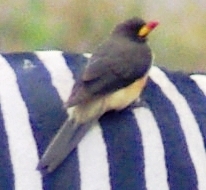Yellow-billed oxpecker
| Yellow-billed Oxpecker | |
|---|---|

| |
| Scientific classification | |
| Kingdom: | |
| Phylum: | |
| Class: | |
| Order: | |
| Family: | |
| Genus: | |
| Species: | B. africanus
|
| Binomial name | |
| Buphagus africanus Linnaeus, 1766
| |
The Yellow-billed Oxpecker, Buphagus africanus, is a passerine bird in the starling and myna family Sturnidae; some ornithologists regard the Oxpeckers to be a separate family, the Buphagidae (Zuccon, 2006). It is native to the savannah of sub-Saharan Africa from Senegal east to Sudan. It is least common in the extreme east of its range where it overlaps with the Red-billed Oxpecker, despite always dominating that species when feeding.

The Yellow-billed Oxpecker nests in tree holes lined with hair plucked from livestock. It lays 2–3 eggs. Outside the breeding season it is fairly gregarious, forming large, chattery flocks. Non-breeding birds will roost on their host animals at night.
The Yellow-billed Oxpecker eats insects and ticks. Both the English and scientific names arise from this species' habit of perching on large wild and domesticated mammals such as cattle and eating arthropod parasites. In a day an adult will take more than 100 engorged female Boophilus decoloratus ticks or 13,000 larvae.
However, their preferred food is blood, and while they may take ticks bloated with blood, they also feed on it directly (Feare 2003), pecking at the mammal's wounds. So the good the bird does to the mammal may be negated by its keeping the wounds open to parasites and disease [citation needed]. Whatever the net result, mammals generally tolerate oxpeckers (Feare 2003).
The Yellow-billed Oxpecker is 20 cm long and has plain brown upperparts and head, buff underparts and a pale rump. The feet are strong. The bill is yellow, tipped red. Its flight is strong and direct. The call is a hissy crackling krisss, krisss.
References
- Template:IUCN2006 Database entry includes justification for why this species is of least concern
- Birds of The Gambia by Barlow, Wacher and Disley, ISBN 1-873403-32-1
- Feare, Chris J. (2003). "Starlings and Mynas". In Christopher Perrins (Ed.) (ed.). Firefly Encyclopedia of Birds. Firefly Books. pp. 530–533. ISBN 1-55297-777-3.
- Starlings and Mynas by Feare and Craig, ISBN 0-7136-3961-X
- Zuccon, Dario; Cibois, Anne; Pasquet, Eric & Ericson, Per G.P. (2006): Nuclear and mitochondrial sequence data reveal the major lineages of starlings, mynas and related taxa. Molecular Phylogenetics and Evolution 41(2): 333-344. doi:10.1016/j.ympev.2006.05.007 (HTML abstract)

